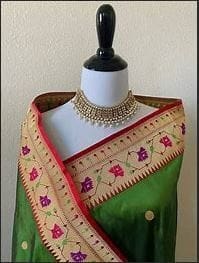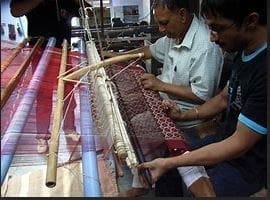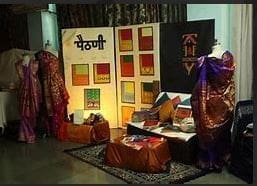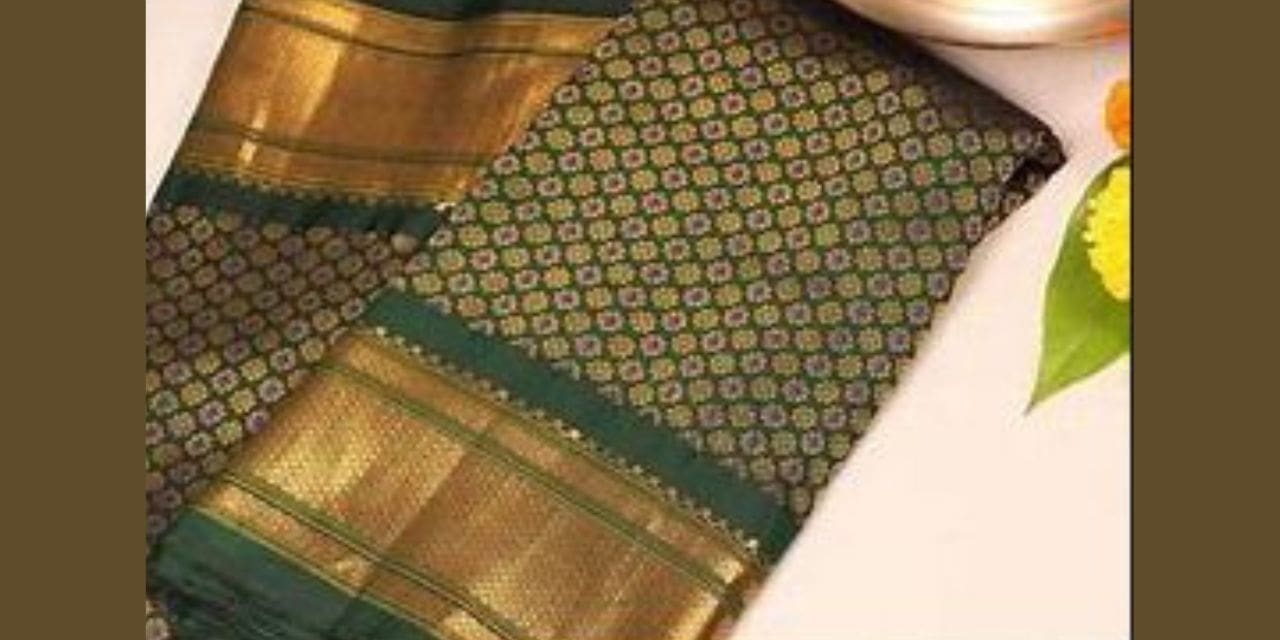The Paithani Saree is one of the most royal sarees of India. These six yards of traditionally woven elegance, come with exquisite Zari borders, intricate designs and complementary motifs that highlight the cultural heritage of Maharashtra, the origins of Paithani. The Paithani sarees are woven prominently in Paithan and other parts of Maharashtra, like the towns of Yeola, Pune, Nashik and Malegaon.
These Sarees were earlier woven using handlooms for the queens and other royalties. However, now they are mass produced on a larger scale and are one of the most popular choices of brides to be worn on their wedding day! Paithani Sarees are now available all over India and have become quite popular internationally as well, with many celebrities draping the Paithani on prominent occasions.

The Paithani, when woven traditionally, consists of the body made of pure silk and the borders made of gold and silver zari. Earlier, these sarees used to have a plain body and a large pallu and heavy border. With time there has been the addition of numerous motifs to the saree. The most commonly used motif on the Paithani is the peacock, locally known as ‘Bangadi Mor’. Other motifs that are woven in the saree include the lotus flower, swan, coins, flowering vine, stars, circles, clusters of leaves and geometric shapes. The Paithani sarees are woven in various colours, either of pure colours or blended yarns.

The Paithani is unique in its own sense and style of weaving. It resembles the Gara embroidery and leaves no threads hanging. All the yarns are sealed off completely, giving no chances of entanglement. The main body of the saree is woven on hand loom, while the border and the pallu is woven using the tapestry weaving technique. Earlier, silk was used in weft designs as well as in the borders and cotton was used in the body. Over time, Paithani has evolved into a silk saree completely, with no traces of cotton. There are three types of silk threads that are commonly used in the Paithani saree: the Charkha, (widely used, comparatively cheaper); Ciddle-Gatta (fine quality silk, thin shear, shiny, smooth and even); and China Silk (very expensive).
Depending on the details and intricacy of the saree, it can take from somewhere around six months to two years to weave a Paithani saree. The trend of Paithani can also be seen in dress materials, scarves and other household items as the weavers are keen to enter into a diversified market.
Today, the market is flooded with fake power loom Paithanis. These are easier and faster to manufacture. Each Paithani takes five to six hours to manufacture. The designs are fed into a computer and the power loom has the capability to duplicate designs. These Paithanis, due to their ease of manufacture, are priced competitively and range from Rs. 2000 to Rs. 10,000. Another cheaper Paithani is the Yeola Paithani which is done on a Kadhiyal loom and is also faster to weave. The original Paithan Paithani is a GI product and hence is protected under the The Geographical Indications of Goods (Registration & Protection) Act, 1999 and the Geographical Indications of Goods (Registration and Protection) Rules, 2002 (Mathew 2009). But, due to lack of awareness of the defining points of a Paithani, customers today are not aware of the finer points of the Paithani and hence are easily duped by shops. A quick customer survey showed that in traditional saree shops that are patronised by families for generations, a power loom Paithani is often sold at the cost of a handloom Paithani as the customers are not aware of the original product and trust the shop owner. Even in Paithan, several shops can be found which promise a Paithani at prices as low as Rs. 500 to Rs. 2000.

It is to be noted that, a real Paithani has several distinctive signs to identify it as a handloom Paithani from Paithan, including observing the motifs closely, examining the cloth and zari, looking for faults and warps in the saree, etc. No two Paithani sarees are exactly the same as each saree is woven individually and has different and unique motifs. However, power loom sarees tend to be similar and cater to a larger set in terms of motifs, colours and arrangements.
The issues thus faced by handloom sarees are that since the price is very high, there is a lesser demand for authentic handloom Paithanis. The demand for sarees too has reduced as women today prefer having something easy to manage and maintain.
The weaver’s community is shrinking as well and it is harder to find traditional weavers or weavers having complete knowledge of the techniques. As the process of weaving is slow and tedious, the younger community does not prefer doing the traditional jobs and are migrating towards the cities. This has caused loss of traditional knowledge systems of weaving. Certain institutions and the Textile Ministry are, however, taking steps to counter loss of weavers and hold training programmes for new weavers. The Mahratta Paithani Center trains women from the Sali, Koshti and Momin communities in preparing the loom and weaving. This has caused a shift in the demography of weavers in Paithan from a male-centric occupation to a female-centric one.
The Paithani Weavers Association has also diversified their range of products into throws, covers, fabric pouches and salwar suits to adjust to the changing markets. While the Paithani saree remains a choice for brides across Maharashtra, the demand for other products has also risen. However, there is a need for professional designers to create a market for the fabric of the Paithani and create products to suit the current trends while retaining the traditional techniques, motifs and colours as well as reviving the organic methods of dyeing and preparing the silk.
There is also a need to create some awareness about these Paithani sarees amongst the customers and the shop owners as well. Awareness of the GI, Silkmark and Handloom Mark must also be increased among the general public and the customer must ensure that the Paithani they are buying contains all three tags.

